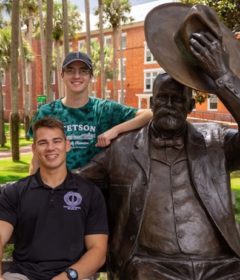Exploring Cultural Credit
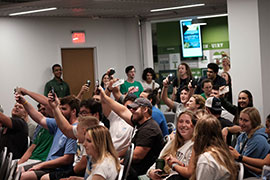

Photo: Jacob Mauser ’20
As a first-year student arriving at Stetson in August 2018, Kate Carter had plenty to keep her busy, especially since she also played on the women’s soccer team. Yet, there’s one aspect of campus life that Carter regrets initially not exploring: cultural credit events.
“I learned about cultural credits from my teammates on the soccer team who were juniors and seniors at the time,” Carter said. “I most definitely did not take good advantage of them last year, seeing that I only landed about three of them on my degree audit. However, this year I am happy to say I am really taking in the sights.”
In addition to meeting classroom course requirements, students at Stetson must attend at least three approved cultural events for each semester of enrollment and receive at least 24 cultural credits prior to graduation. The events, held away from the classroom, are designed to provide “substantial intellectual or cultural value,” according to the university’s official description of the program. Students can find the events on the Stetson University calendar.
In essence, cultural credits allow students to explore multiple subject areas and more fully embrace the university’s mission and values, with the events connecting the real world to what students learn, and often outside their major courses of study. Most of the events occur on campus; only a few off-campus sites are approved for cultural credit. The events vary widely in form, ranging from lectures, concerts and art shows to film screenings and literature discussions.
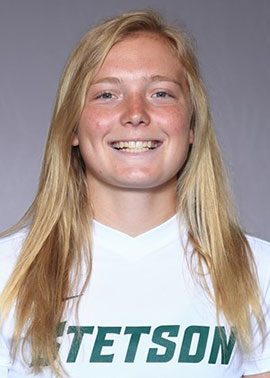
Even open-mic nights.
That’s where Carter often can be found — at Uncouth Hour, where students on campus can share short stories, poetry, digital or instrumental music, singing, comedy, magic acts and more. The event, held each Thursday at 9:30 p.m. in Lee’s Garage at the Carlton Union Building, is affiliated with Hatter Network, part of Stetson’s Student Media Group.
Crystal Baroni, student media coordinator for Hatter Network, calls Uncouth Hour an “amazing weekly opportunity for students to connect and get cultural credit.”
Carter describes it as “never the same.”
“I have been up at the mic three separate nights, and I can confidently say the energy in the room is always unique,” Carter said in December. “Also, Uncouth Hour provides a totally needed method for students outside the art school to express themselves. What could be better than more moments of self-expression from the student body? To me, that’s what it’s all about.”
During Fall Semester 2019, several other events educated and entertained while also delivering those needed cultural credits.

For example, Florida’s stone and geological history took center stage in “Agatized Coral and Other Silicified Fossils,” an exhibit at Stetson’s Gillespie Museum that featured an array of rare agatized and silicified corals, plus other silicified fossils from the personal collections of renowned Florida geologists. The exhibit came with an activity worksheet, self-guiding students through interpretive materials and displays.
Similarly, the Gillespie Museum hosts monthly Science Cafés, with engaging speakers from across campus and throughout the region offering insight on issues related to earth and environmental science.
There’s plenty of gallery art, too.
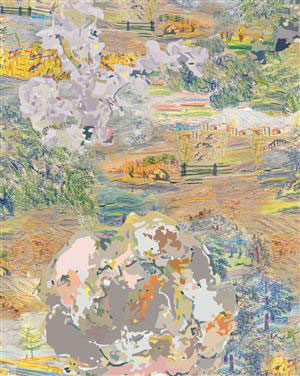
Consider “Garniture,” a selection of Oscar Bluemner’s work with a twist, presented by Visiting Digital Arts Professor Madison Creech, MFA, at Stetson’s Hand Art Center. Think “digital collages.” Bluemner’s color schemes and textures are preserved, while contemporary abstraction tools and The Vogue Archive motifs (from the early 1900s) create an uncommon collaboration with the famous late artist.
Or, want to enjoy live theater and receive cultural credit for it?
Beginning Feb. 20, “Mrs. California by Doris Baizley” is being performed by Stetson’s Second Stage Theater, housed at a performance complex inside DeLand’s Museum of Art.
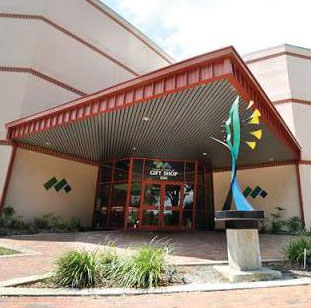
Picture the pre-women’s lib year of 1955 at a Los Angeles hotel, where a homemakers contest is in progress. The contestants are expected to demonstrate the skills of the ideal housewife in an attempt to be crowned as Mrs. California. Then see what can happen when one woman decides to stop doing what she is “supposed to do” and starts doing what she was “meant to do.” The show is both thought-provoking and funny, and students get cultural credit.
Even if Carter wasn’t receiving cultural credits for attending such events, she might well attend anyway. The soccer athlete/scholar believes they are a win-win.
“Credits are mandatory; that is true. But impartially speaking, a majority of cultural credit events I have attended I would have gone to with or without ‘credit,’ because I usually have fun and I always learn something,” Carter said. “Not to mention it is a good way to branch out and meet friends outside of my everyday scope.
“It is very clear to me that a large amount of time and resources are put into these events to give students this opportunity, and I think at its core, cultural credit events are simply an awesome excuse for us students to leap outside of our declared majors.”
-Michael Candelaria



